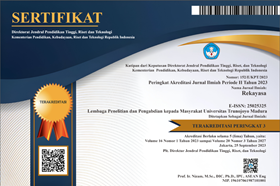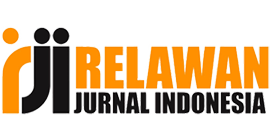Analisis Kecenderungan Musiman Tinggi Gelombang Signifikan di Laut Indonesia Tahun 1980-2020 Untuk Mendukung Pembangunan Pesisir Berkelanjutan
Abstract
Sea level rise, as one of the consequences of global climate change, has significantly impacted oceanographic dynamics, particularly wave characteristics. One of the most critical affected parameters is significant wave height, which directly influences maritime safety, the sustainability of fisheries, the stability of coastal infrastructure, and the risk of coastal erosion and tidal flooding. As an archipelagic nation with the second-longest coastline in the world, Indonesia is highly vulnerable to such changes. Therefore, understanding the spatial and temporal trends in significant wave height is essential to support effective adaptation and mitigation policies in coastal regions. This study aims to analyze the trend of increasing significant wave height in Indonesian waters using ERA5 reanalysis data from the European Centre for Medium-Range Weather Forecasts (ECMWF) over the period from 1980 to 2020. The trend analysis was conducted using non-parametric statistical methods, namely the Mann-Kendall test to detect statistically significant trends and Sen’s Slope Estimator to quantify the rate of change. A significance level of 0.05 was applied in the analysis. The results indicate a significant upward trend in significant wave height across several Indonesian maritime regions. Conversely, the northern waters of Central Java and the northern region of Masalembu Island exhibited no statistically significant trend across seasons. The Banda Sea and southern Papua experienced significant increases during the dry season (JJA) and the second transitional season (SON), with a peak rate of 1.70 cm/year. In the southern waters of Lombok Island, positive trends were observed in the wet season (DJF) and the first transitional season (MAM), with rates reaching 1.46 cm/year. The highest trend was recorded in the southern waters of Java during the wet season (DJF), at 1.72 cm/year. These findings suggest that most Indonesian waters are experiencing significant changes in wave characteristics as a result of climate change, highlighting the urgency for long-term oceanographic monitoring and the integration of wave data into coastal development and climate adaptation strategies.
Keywords
Full Text:
PDF (Bahasa Indonesia)References
Alemu, Z. A., & Dioha, M. O. (2020). Climate change and trend analysis of temperature : the case of Addis Ababa , Ethiopia. Environmental Systems Research, 9(27), 1–15. https://doi.org/10.1186/s40068-020-00190-5
Bramawanto, R., & Abida, R. F. (2017). THE CLIMATOLOGY ASPECT REVIEW ( ENSO AND IOD ) AGAINST THE PRODUCTION OF SALT IN INDONESIA. Jurnal Kelautan Nasional, 12(2), 91–99.
De Leo, F., De Leo, A., Besio, G., & Briganti, R. (2020). Detection and quantification of trends in time series of significant wave heights: An application in the Mediterranean Sea. Ocean Engineering, 202(February), 107155. https://doi.org/10.1016/j.oceaneng.2020.107155
Fadlan, A., Aror, R. D., Sugianto, D. N., & Zainuri, M. (2017). Monthly Variation Characteristics of Wave Height In North Sulawesi. Waste Technology, 5(April), 21–26.
Fahruddin Rais, A., & Yunita, R. (2016). Profil Musiman Gelombang Laut di Laut Sulawesi. Jurnal Riset Dan Kajian Pendidikan Fisika, 3(1), 1. https://doi.org/10.12928/jrkpf.v3i1.4537
Gocic, M., & Trajkovic, S. (2013). Analysis of changes in meteorological variables using Mann-Kendall and Sen ’ s slope estimator statistical tests in Serbia. Global and Planetary Change, 100, 172–182. https://doi.org/10.1016/j.gloplacha.2012.10.014
Habibi, M. N., Fitria, W., & Sofian, I. (2018). KAJIAN INDEKS VARIABILITAS TINGGI GELOMBANG SIGNIFIKAN DI INDONESIA. Jurnal Segara, 14(3), 159–168.
Handoko, E. Y., Yuwono, & Ariani, R. (2019). ANALISIS KENAIKAN MUKA AIR LAUT INDONESIA TAHUN 1993-2018 MENGGUNAKAN DATA. Journal of Geodesy and Geomatics, 15(1), 58–64.
Imura, N. M. (2013). Review Sea-level rise caused by climate change and its implications for society. Proc. Jpn. Acad., 89(7), 281–301.
K. H. Hamed and A. R. Rao, "A modified Mann-Kendall trend test for auto correlated data", Journal of Hydrology, no. 204, pp. 182-196, 1998.
Kurniawan, R., Habibie, M. N., & Suratno, S. (2011). Variasi Bulanan Gelombang Laut Di Indonesia. Jurnal Meteorologi Dan Geofisika, 12(3), 221–232. https://doi.org/10.31172/jmg.v12i3.104
Kurniawan, R., & Khotimah, M. K. (2015). Ocean Wave Characteristics in Indonesian Waters for Sea Transportation Safety and Planning. IPTEK, The Journal for Technology and Science, 26(1), 19–27.
Lang, P. E., Carslaw, D. C., & Moller, S. J. (2019). A trend analysis approach for air quality network data. Atmospheric Environment: X, 2(March), 100030. https://doi.org/10.1016/j.aeaoa.2019.100030
M. G. Kendall, "Rank Correlation Methods" in, London, U.K.:Charles Griffin, 1975.
Mori, N., Yasuda, T., Mase, H., Tom, T., & Oku, Y. (2010). Projection of Extreme Wave Climate Change under Global Warming. Hydrological Research Letters, 4(0), 15–19. https://doi.org/10.3178/hrl.4.15
P. K. Sen, "Estimates of the regression coefficient based on Kendall's tau", Journal of American Statistical Association, vol. 39, pp. 1379-1389, 1968.
Rais, A. F. (2019). Pengaruh ElNino pada Gelombang Signifikan di Perairan Indonesia. JURNAL FISIKA DAN APLIKASINYA, 15, 45–49.
Sierra, J. P., & Casas-Prat, M. (2014). Analysis of potential impacts on coastal areas due to changes in wave conditions. Climatic Change, 124(4), 861–876. https://doi.org/10.1007/s10584-014-1120-5
Zikra, M., Suntoyo, & Lukijanto. (2015). Climate Change Impacts on Indonesian Coastal Areas. Procedia Earth and Planetary Science, 14, 57–63. https://doi.org/10.1016/j.proeps.2015.07.085
DOI
https://doi.org/10.21107/rekayasa.v18i2.29978Metrics
Refbacks
- There are currently no refbacks.
Copyright (c) 2025 Muhammad Baharudin Fahmi, Harish Wirayuhanto

This work is licensed under a Creative Commons Attribution-ShareAlike 4.0 International License.
























